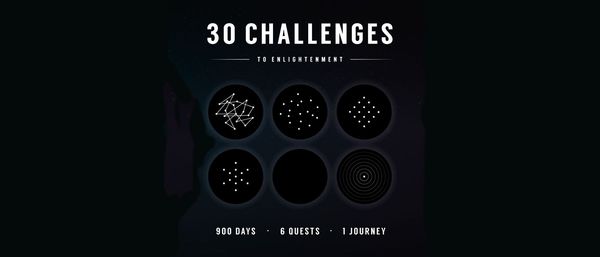Sam Thomas Davies • • 5 min read
Why You Should Find Your “X-Spot” If You Want To Succeed

In 1884, Clark Hull was born in a log house in Akron, New York to an impoverished family. This would be the least of his concerns: For much of his childhood and adolescence, he would be plagued with health problems.
First, as a child, Hull was diagnosed with typhoid fever and left with impaired vision and memory. Second, as a university student, he was diagnosed with Polio and left without the use of one of his legs.
However, despite his streak of bad luck, after 10 years of overcoming multiple obstacles and working several menial jobs to pay his tuition, Hull graduated with a well-earned PhD in psychology.
Hull could’ve easily eased off in his academic endeavours upon graduation (and, given his circumstances, would’ve be excused for doing so), but for Hull, this was only the beginning. In fact, unbeknownst to him at the time, Hull was onto something big.
Hull’s Goal Gradient Theory
It has struck me many times that the human organism is one of the most extraordinary machines—and yet a machine
– Clark Hull.
Perhaps, because of his own triumphs in the face of adversity, Hull became fascinated by goal attainment and began studying it, particularly, how rats searched for a reward in a maze.
After 10,000 hours of experimentation, Hull stumbled up an irregular pattern; one he hadn’t anticipated (and one that we now hold to be true): The closer the rats got to their goal – that is, finding a reward in a maze – the faster they got.
Humans, is seems, are no different.
X Marks the Spot
In a 26.2 mile marathon, there’s an unusual event that occurs in the brains of runners at the 26.1 mile mark.
When runners turn the corner and see the finish line, their brains are suddenly flooded with endorphins and other chemicals that give them the much-needed boost to accelerate across the finish line.
It’s called “The X-Spot”.
Shawn Achor, a positive psychologist and author of Before Happiness: Five Actionable Strategies to Create a Positive Path to Success writes:
At the precise moment your brain realizes that attaining your goal is not only possible but probable, it releases a potent stream of chemicals that help you speed up . . . the closer you perceive success to be, the faster you move toward it. [1]
If X-Spots can be applied to running, can we apply them to other goals as well?
The answer can be found in the most unlikely of places: Coffeehouses.
How Long Does It Take You to Receive a Free Coffee?
Hull was a behaviourist: He believed that our brains rely on objective rules of behavior. But because behaviourism is often overlooked in modern academia, unfortunately, so were his discoveries.
That was until 2006, when researchers at the Columbia University Graduate School of Business did a series of fascinating studies that modernised Hull’s hypothesis in a business context.
The researchers were interested in how local coffee shop customers would behave when participating in a customer reward programme.
The setup was as follows: The customers were given a stamp card and were told for every purchase, they would get a stamp. If they received 10 stamps, they would receive a free coffee.
The researchers then recorded the dates the customers purchased their coffees. They wanted to know whether the customers would buy coffee with higher frequency the closer they got to the free coffee.
And, just as Hull’s hypothesis predicted, that’s exactly what happened. The closer the customers got to their tenth coffee, the more regular they returned to the coffee shop.
But wait, there’s more…
The researchers repeated the experiment, but this time half of the customers got a “buy 10 coffees and get one free” card (Group A) and the other half received a “buy 12 coffees and get one free card” – but with two stamps to begin with (Group B).
In other words, both groups needed to buy 10 coffees to a get a free one, but Group B had a perceived headstart.
Group A hadn’t even started but the Group B were already one sixth of the way there. Buying a coffee in Group A would only bring them one tenth (10 percent) of the way towards a free coffee, but in Group B, it brought them one third (33 percent) closer.
The distance both Group A and Group B had to make was identical, but the customers in Group B – those who perceived the goal as closer – got the free coffee faster than anyone in Group A. [2]
The lesson here is not only do we accelerate towards our goal when the end is in sight, but having endowed progress – a perceived headstart – works to our advantage, even if it is artificial.
How You Can Use This
Not only do we work harder and faster when we get objectively closer to our goal, but when we perceive we are as well.
In other words, it’s not your objective proximity to your goals that’s important, but your subjective perception of that objective reality.
The easiest way to do this is to (1) Use endowed progress: Move towards an outcome that already has progress built in and (2) Identify X spots: Help your brain believe that success is close, achievable, and worthwhile. Set mileposts at the 70 percent mark and periodically check distance already covered.
Writing a book can be a daunting task, but if you redirect your focus from what you’ve left to do to what you’ve done already – say, the chapter you’ve written – you’ll feel endowed with progress.
Similarly, checking your progress at the 70% mark (say, with each chapter’s completion) will remind you of how much you’ve already achieved.
Remember: When you know you’re nearing your goal’s completion, your brain releases those success accelerants that will increase your motivation to speed up your progress.
With that said, there’s one caveat: Don’t disregard the process. The process will motivate you when you feel demotivated, help you build forward momentum and even adapt if need be.
When You Lose Momentum
Demotivation is often inevitable with any long-term goal. That said, it’s necessary to have an effective strategy in place.
Minjung Koo and Ayelet Fishbach at the University of Chicago have found that in situations where you’re less committed or motivated, the best way to accelerate growth is to look, not ahead to the finish line, but behind you at what you’ve already accomplished. [3]
If you’re dieting, don’t concern yourself with the weight you’ve yet to lose (that’ll only discourage you), concern yourself with you’ve lost already.
If you’re an entrepreneur and canvasing for new clients by cold calling 10 new prospects a day, three calls in, don’t focus on the seven you have left, focus on the three you’ve done and what you learnt from them.
If you’re in debt, worrying about the remaining balance isn’t going to clear it, but reminding yourself of what you’ve already paid (and will continue to pay), will.
The more you invest in moving towards a positive outcome (while being process-orientated), the more you begin to care about it. This is called “escalation of commitment”.
If you want to accelerate your success rates, escalate your commitments. Find your X-spots early and often and be sure to remind yourself of your progress. You’re often a lot closer than you think.
Sources
[1] Achor, S. (2013) Before Happiness: The 5 Hidden Keys to Achieving Success, Spreading Happiness, and Sustaining Positive Change, New York: Crown Publishing Group.
[2] Ran Kivetz, Oleg Urminsky, and Yuhuang Zheng (2006) The Goal-Gradient Hypothesis Resurrected: Purchase Acceleration, Illusionary Goal Progress, and Customer Retention. Journal of Marketing Research: February 2006, Vol. 43, No. 1, pp. 39-58.
[3] Minjung Koo and Ayelet Fishbach, “Dynamics of Self-Regulation: How (Un)accomplished Goal Actions Affect Motivation”, Journal of Personality and Social Psychology 94, no. 2 (2008); 183:95
This post is republished with permission of the original author.
This original can be found at samuelthomasdavies.com










